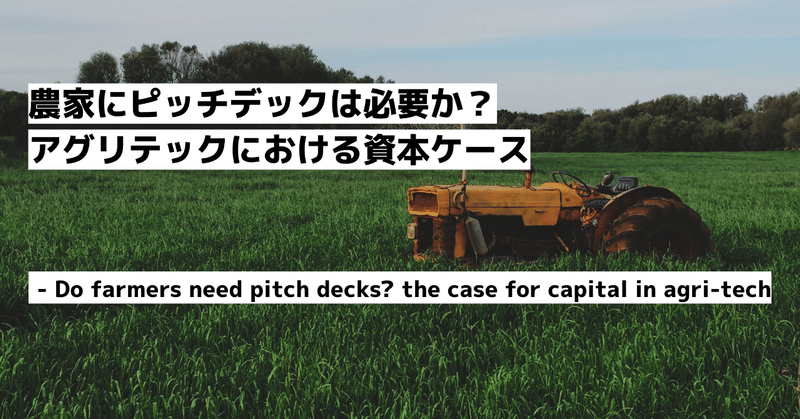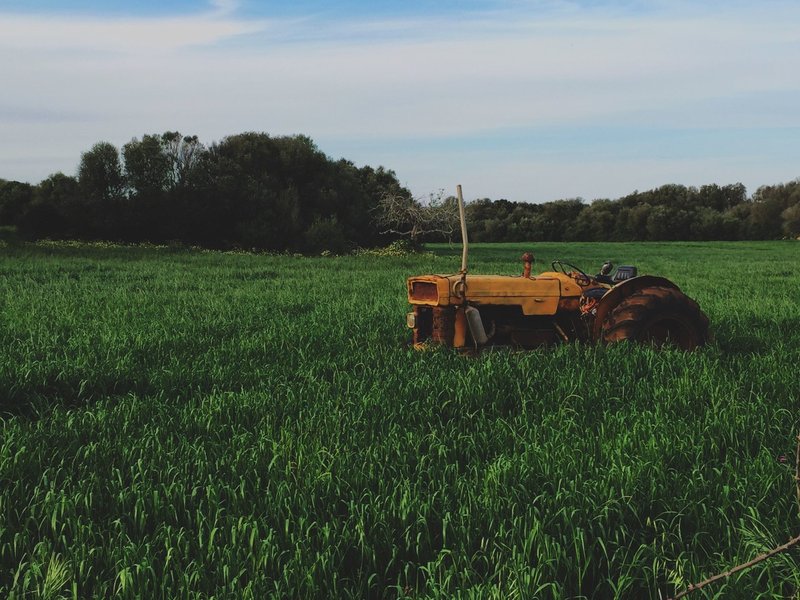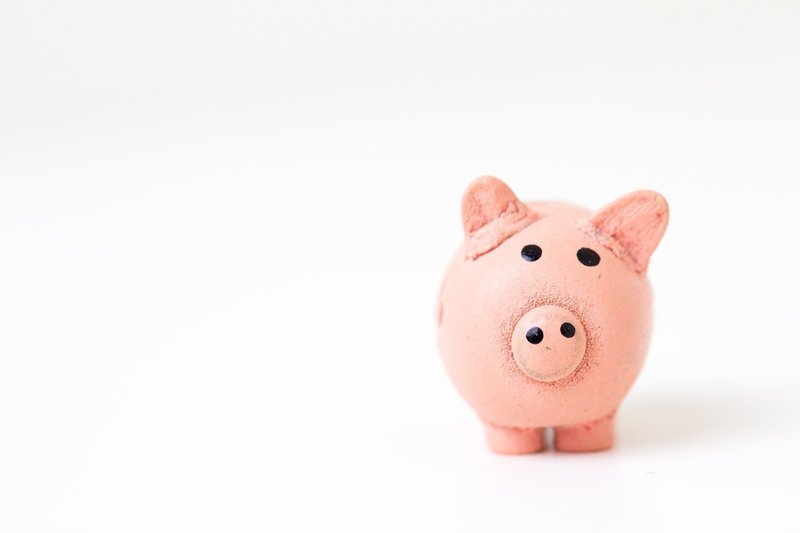
農家にピッチデックは必要か?アグリテックにおける資本ケース - Do farmers need pitch decks? the case for capital in agri-tech
このnoteは海外の記事を日本語翻訳したものです。海外は日本よりもテック化が進み合理性を求める傾向がありますが日本では必ずしもそれが正しいとは限りませんので、今後の農業界のテックの潮流の参考程度に読んで頂けると幸いです。

農家にピッチデック*は必要なのか?アグリテックにおける資本のケース
- Do farmers need pitch decks? the case for capital in agri-tech
農業における資本不足に対処するということは、他のすべての付加価値を持つ解決策が、農家が彼らにふさわしいより良い生活(毎日大変な作業ですからね...)を送るのにさらに大きな影響を与えることを意味します。
Addressing the lack of capital means that all other value-added solutions will have an even greater impact in propelling farmers into better lives that they all deserve.
* ピッチデック: 基本的にはスタートアップが資金を調達する際に投資家に説明する簡単なプレゼンテーションのこと
農業者として生きていくということ
- Bootstrapping farmers
農民は社会の中で最も無視されてしまうセグメントの1つであるため、東南アジアでのアグリテックの勃興は称賛されるべきですが、この分野はしばしば問題の一部のみに集中しがちです。ソリューションの大部分は、農家が収穫量を改善または向上させるのに役立ちます。ここで述べられる仮説は、農家が現在の作物から十分な収入を得ていない場合、収穫を改善すれば結果として富も改善するのではないか?ということです。
While the advent of agri-tech in Southeast Asia is to be praised – as farmers are one of the most ignored segments in society – the field often tends to be hyper-focused on only one part of the problem. The vast majority of solutions help farmers improve their yields. The working thesis here is that if they are not earning enough income from their current crops, improving their harvest will, in turn, improve their wealth.
そのため、農家に対面またはデジタルを通じて教育を提供し、そして現代の農業のベストプラクティスを伝えるスタートアップがいくつかあります。他にも、農家たちにより正確または包括的なリアルタイムのデータまたは分析を提供し、ほ場の傾向をより情報に基づいて決定できるようにします。今も、農家の収穫高の増加に直接貢献できるようなツールを農家に提供しているスタートアップもあります。
So we see some startups that provide in-person or digital education to farmers, teaching them the best practices of modern agriculture. Others provide these farmers with more accurate or comprehensive real-time data or analytics so that they can make more informed decisions about how to tend to their farm. Still, others give farmers tools that directly contribute to increasing the yield of their farms.
誤解しないでいただきたいのは、これらのアプローチはすべて、東南アジアの農業における重要かつ課題の大きなニーズに対処するものであり、この動きは称賛されるべきですが、まだ農家が必要とするものの一部のみしか満たせていません。最良の事例を想像してみてください。たとえば、ベトナム、インドネシア、またはフィリピンの地元農家は、地元の農業技術のすべてのソリューション(教育、データ分析、ツール)を活用し、収穫を15%改善するとしましょう。
Don’t get me wrong. All of these approaches address crucial needs in Southeast Asia’s agriculture and should be applauded, but they only fulfill one part of what farmers need. Just imagine the best case example: Let’s say local farmers in Vietnam, Indonesia, or the Philippines uses all the solutions of their local agri-tech – the education, the data analytics, the tools – and improves their yield by 15 per cent.
それは大きな違いのように聞こえるかもしれませんが、それは毎月の増加ではありません。農場では年に数回しか収穫が行われないため、この増加は予想よりはるかに少ないのです。農民は、より多くの土地、労働、または他の資源に投資することによって、実際にビジネスとして農場を成長させるのに十分なお金を節約するために、非常に一生懸命に働かなければなりません。スタートアップ界隈の言葉を借りると、農家たちは自らの手で業を起こさねばなりません。
That may sound like a significant difference, but that is not a monthly increase. Since farms produce harvests only several times a year, this increase is a lot less than it sounds. Farmers will still have to work very hard to save enough money to actually grow their farm as a business by investing in more land, labour, or other resources. To borrow terminology from the startup world, these farmers have to bootstrap.

農業における信用格差 - The credit gap in agriculture
再びスタートアップ界の言葉を借りると、はるかに優れたアプローチは、農家たちが資本にアクセスできるようにすることです。資本注入により、彼らは農場をはるかに速く成長させることができ、そしてその結果、自給自足的な農業を実際の「農業ビジネス」に変化させることで生活水準の向上を享受することができます。残念なことに、多くの理由により、ほとんどの農家はいかなる形態の資本にもアクセスできておりません。金融リテラシーが不足している人もいれば、ローンとは何かを知らないような状況です。
A much better approach – to borrow terminology from the startup world again – is for them to gain access to capital. A capital injection would allow them to grow their farms much faster, and in turn, enjoy the improved standards of living that will come from growing their subsistence farming into an actual agribusiness. Unfortunately, most farmers lack access to any form of capital, due to a plethora of reasons. Some lack financial literacy and do not know what loans are.
他の人は、作物には有益かもしれないが、銀行があるような都心部からは離れた地域に住んでいます。金融リテラシーを持ち、銀行にアクセスできるような人は、必要な個人データや金融文書を持っていない可能性があります。ローンを得ることができる幸運な少数の人々は、しばしば、毎月毎月利子のみを支払うことになり、元本を切り捨てることができないほど高い略奪的ローン(高利率な融資)の対象となります。
Others live in areas that may be beneficial for crops but are remote from banks. Those that do have financial literacy and have access to banks may not have the required personal data or financial documents. The lucky few who are able to get a loan are often subject to predatory loans that are so high that they often end up paying only the interest month-after-month and cannot chip away at the principal.
農業の信用格差を考えると、アグリテックはビジネスにおける財務面にも焦点を合わせなければなりません。従来のアグリテックソリューションと相まって、金融ベースのソリューションは、農民を貧困から繁栄へと加速させるための増強装置として機能することでしょう。
Given the credit gap in agriculture, agritech must also focus on the financial aspect of the business. Coupled with traditional agritech solutions, finance-based ones will serve as a force multiplier, accelerating farmers out of poverty and into prosperity.
初期の金融ベースのアグリテックソリューションのいくつかは、PtoP(ピアツーピア)の貸付モデルを採用し、それを現場に適用しています。その一例がインドネシアのi-Growです。農家は投資家から資金を受け取って農業経営を拡大し、その結果、9〜13%の利益を得ることができます。 i-Growでは、プラットフォームを通じて実際の投資を促進するだけでなく、アプリを通じて作物の成長をチェックすることもできます。
Some of the earliest finance-based agritech solutions take the peer-to-peer lending model and apply it to the field. One such example is i-Grow from Indonesia. Farmers receive capital from investors to grow their farming operations, and they, in turn, get a return of 9 to 13%. Apart from facilitating the actual investment through its platform, i-Grow also enables investors to monitor the growth of their crops through an app.
アジア開発銀行が支援するプロジェクトで試験運用を行うフィンテックスタートアップ
- Fintech startup to pilot solution in ADB-backed project
しかし、フィンテック自体がシンプルなデジタルウォレットから本格的なエコシステムに進化したように、アグリテックにおける金融ソリューションも能力を飛躍的に高める必要があります。この目的に向けた最も有望なソリューションの1つは、フィリピンのアグリフィンテックスタートアップのAsensoによるものです。 Asensoは、人工知能、チャットボット、自然言語処理(NLP)などの最先端技術を活用することで、
①MSMES全般および特に農家が公正な金利で資本にアクセスできるようにするプラットフォーム
②農業生産コストを削減する統合サプライチェーン
③農家が直接顧客と出会うのを支援するマーケットプレイス
④非常に脆弱なセクターに対してのマイクロ保険の保護
これらを構築しています。
But just as fin-tech has itself evolved from simple digital wallets into full-fledged ecosystems, so, too must finance solutions in agritech leap forward in capability. One of the most promising solutions toward this end is by the agri-fintech startup Asenso from the Philippines. Leveraging bleeding edge technology like artificial intelligence, chatbots, and natural language processing (NLP), Asenso is building a platform that helps MSMES in general and farmers in particular access capital with fair interest rates, an integrated supply chain that lowers the cost of agricultural inputs, a marketplace to help farmers meet their direct customers, and microinsurance protection for a sector that is to begin with, highly vulnerable.
Asensoのプラットフォームは、自分の土地を耕し自給自足的な生活をしている農家から、実際のビジネス・事業として利益を得ている農業経営者に変われるように設計されています。インドネシア国内最大のマイクロファイナンス機関であるCARD MRIと、サービスが不十分な市場に対処するためのインクルージョン主導(多様性が受け入れられる状態を作り出す事)のスタートアップの構築に焦点を当てたエンタープライズベンチャーアクセラレーターであるTalino Venture Labsに支えられ、Asensoはエコシステムを拡大する戦略的サポートを提供しています。
Asenso’s platform is designed to turn farmers who are just living off their land into agripreneurs who are profiting from a real business. Backed by CARD MRI, the country’s largest microfinance institution and Talino Venture Labs, an enterprise venture accelerator focused on building inclusion-driven startups to address underserved markets, Asenso has the strategic support to scale its ecosystem.
また、同社は最近アジア開発銀行のGlobal AgriFin Innovation Challengeで最優秀賞を獲得しました。これは、デジタル金融サービスで結ばれた小規模農家のニーズに対応するアグリフィンテックコミュニティのデジタル化されたエンドツーエンドの解決策を精査する狙いがあります。アジア開発銀行は、フロンティアテクノロジー(宇宙など先端分野にテクノロジーを使って新たな産業を生み出そうという動き)がどのように自給自足農業から持続可能なアグリビジネスへの移行の中で、食料供給の最大80%に貢献する小規模農家を支援できるかに関して、コミュニティに挑戦しました。
The company also recently bagged the top prize at the Asian Development Bank’s Global AgriFin Innovation Challenge, which aimed precisely to vet digitized end-to-end solutions from the agri-fintech community that would address smallholder farmer needs, tied in by digital financial services. ADB challenged the community as to how frontier technology can help smallholder farmers, who contribute up to 80 per cent of food supply, a transition from subsistence farming to sustainable agribusinesses.
Asensoの優れたソリューションの中核を為すのは、農家の支払い行動から構築されるAI主導の信用スコアリングシステムです。これはネットワーク内の760,000人の農家に対して独自のスコアリングファクターを統合しています。この仕組みにより、Asensoは即座に資本を提供し、クレジットラインをデジタルウォレットに保存し、農家の購買力を高めることができます。Asensoは実際、この地域でアジア開発銀行が支援するプロジェクトでAsensoのプラットフォームを試験的に運用する絶好の機会を得たのです。
At the heart of Asenso’s winning solution is an AI-driven credit scoring system that builds from payment behaviour and blends unique scoring factors specific to the 760,000 farmers within its network. This allows Asenso to instantly provide capital, store credit lines in digital wallets, and leverage the combined buying power of farmers. Asenso’s win came with the chance in fact to pilot their platform in an ADB-backed project in the region.
i-GrowやAsensoのような金融ベースのソリューションが農家の支援に繋がることを期待しているため、アグリテックに対する考え方にパラダイムシフトが生じる可能性があります。我々は、作物の成長を改善・向上させる方法を検討するだけでなく、農家が貧困のサイクルに陥ってしまう原因の根本をさらに詳しく調べる必要があります。
One hopes that finance-based solutions like i-Grow and Asenso will succeed at helping farmers, so there can be a paradigm shift in how we think of agritech. We must not only look at how to improve the growth of crops – we must probe deeper toward the root causes that keep farmers locked into the cycle of poverty.
本記事はこちら:
この記事が気に入ったらサポートをしてみませんか?
